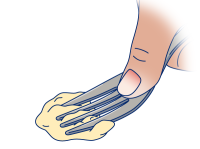This information explains what a level 7 easy-to-chew diet is and how to follow it. It explains how to test your food’s size and thickness. It also lists foods to include and avoid while following this diet.
What is a level 7 easy-to-chew diet?
A level 7 easy-to-chew diet is when you only eat foods that are soft, tender, and need less chewing. You can eat foods with different textures and thicknesses, including chopped, ground, and puréed foods.
On a level 7 diet, you will need to avoid these types of foods:
- Hard, dry, tough, chewy, or fibrous foods, such as fresh pineapple, raw vegetables, and nuts.
- Crispy, crunchy, and sharp foods, such as raw apples and corn chips.
- Foods that have a stringy texture and seeds, such as string beans, pumpkin seeds, and rhubarb.
- Sticky or gummy foods, such as caramel candies and dried fruits.
Why do I need to follow a level 7 easy-to-chew diet?
You may have to follow this diet if you:
- Have dysphagia (dis-FAY-jee-uh). Dysphagia is when you have trouble swallowing.
- Have trouble chewing hard foods, such as dried fruit.
- Have trouble chewing chewy foods, such as marshmallows.
- Had mouth surgery.
- Have lost feelings in parts of your mouth, such as your lips or tongue.
- Have trouble moving parts of your mouth.
How can I make sure my food is soft enough?
You can check your food’s softness by doing a fork pressure test. Follow the steps in this section.
Your food’s texture can change based on its temperature and how you cooked it. Test your food right before you start eating it to make sure it’s the right softness.
Fork or spoon pressure test
Place your fork or spoon over your food. Using your thumb, press down on your fork or spoon until part of your nail turns white (see Figure 1). Your food is soft enough if it is completely squashed and does not go back to its original shape. Your food should also easily break apart with the side of a fork or spoon.

What can I eat on a level 7 easy-to-chew diet?
Here are some foods you can eat while following this diet. We also list some foods you should avoid.
These tables are not a complete list of foods you can eat on this diet. Other foods may be OK to eat if you test them and they are soft enough and the right size.
Milk and dairy
| Milk and dairy to include | Milk and dairy to avoid |
|---|---|
|
|
Proteins
| Proteins to include | Proteins to avoid |
|---|---|
|
|
Vegetables
| Vegetables to include | Vegetables to avoid |
|---|---|
|
|
Fruits
| Fruits to include | Fruits to avoid |
|---|---|
|
|
Starches
| Starches to include | Starches to avoid |
|---|---|
|
|
Fats
| Fats to include | Fats to avoid |
|---|---|
|
|
Soups
| Soups to include | Soups to avoid |
|---|---|
|
|
Sweets and desserts
| Sweets and desserts to include | Sweets and desserts to avoid |
|---|---|
|
|
Other
| Other things to include | Other things to avoid |
|---|---|
|
Sample menu for a level 7 easy-to-chew diet
Use this sample menu to get ideas for making your own level 7 easy-to-chew diet meals.
| Level 7 easy-to-chew diet menu | |
|---|---|
| Breakfast |
|
| Mid-morning snack |
|
| Lunch |
|
| Mid-afternoon snack |
|
| Dinner |
|
| Evening snack |
|
Tips for adding more calories to your diet
- Eat small meals 6 to 8 times a day instead of 3 main meals.
- Add 2 to 4 tablespoons of canned coconut milk or cream to smoothies, shakes, cereals, and yogurts for extra calories. You can also add it to dishes for extra calories, flavor, and moisture.
- Choose creamy soups rather than soups with clear broths.
- Have puddings and custards rather than gelatin desserts, such as Jell-O.
- Add sauces, gravies, butter, or extra vegetable oil to your meals.
- Drink fruit shakes or fruit smoothies made with yogurt or ice cream.
- Make ice cubes from milk or fruit nectar. Use these high-calorie ice cubes in smoothies or to keep your shakes cold. As they melt, they will add calories to your drinks.
- Drink high-calorie drinks, such as whole milk, milkshakes, or pasteurized eggnog.
- Use oral nutrition supplements, such as Ensure® or Boost®, as a nutritious, high-calorie liquid base in smoothies and milkshakes.
- Add honey to smoothies, tea, yogurt, hot cereals, shakes, or ice cream.
- Add sour cream, half and half, heavy cream, or whole milk to your foods. You can add them to mashed potatoes, sauces, gravies, cereals, soups, and casseroles.
- Add avocado to dishes or smoothies and blend.
- Blend nut butters, such as peanut butter, into shakes and smoothies.
Tips for adding more protein to your diet
- Add pureed tofu to cooked vegetables, soups, or smoothies. You can also eat tofu instead of chicken or meat if you’re having trouble eating animal proteins.
- Add pureed cooked eggs to your soups, broths, and cooked vegetables.
- Use plain full-fat Greek yogurt in smoothies, cream sauces, or wherever you would use sour cream.
- Use a plain protein powder, such as whey or pea protein powder, in liquids and shakes.
- Add full-fat ricotta cheese to moisten a dish and add calories and protein.
- Add cottage cheese to smoothies or pureed fruit.
Contact information
If you have questions or want to make an appointment with a clinical dietitian nutritionist, call 212-639-7312.
